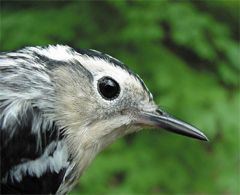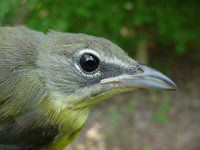 HOME: www.hiltonpond.org |
|
||
|
|
|||
|
|
|||
|
|
|||
|
|
|||
|
|
|||
|
THIS WEEK at HILTON POND |

|
We've all heard urban myths that hummingbirds hitch rides on the backs of Canada Geese or that 12-foot alligators live in sewers of major U.S. cities. At this time of year, another falsehood travels around: That you should never, ever, never eat a persimmon before the first frost. 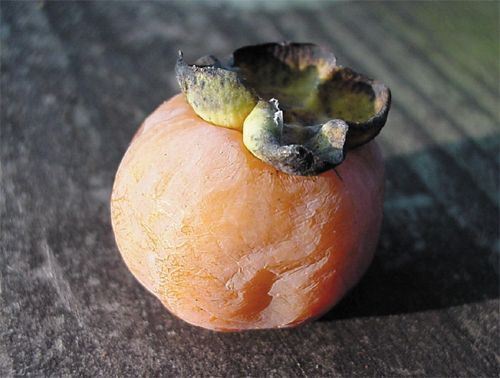 The first two of these are obvious misconceptions. Even so, we almost hate to blow the whistle on the fable about Common Persimmons (above), for at Hilton Pond Center they are--next to blackberries--our finest wild fruit. And as long as folks keep waiting for first frost so persimmons can ripen, there will be that much more fruit we can gobble up without having to share. That may sound selfish but is understandable when we're dealing with the Common Persimmon tree, whose genus (Diospyros) translates from the Greek as "food of the gods."
Here in the Carolina Piedmont we're probably a month away from our first frost, and by then much of the Common Persimmon fruit may be long gone;
In Common Persimmon, male and female flowers are borne on separate trees, so it's essential to have both if you want fruit production. Ripe persimmons are a pleasing pinkish-orange color throughout, and the skin usually has a frosted appearance. Often there are surface blemishes, but these are only cosmetic and do not affect the taste. Each autumn the area beneath our stately persimmon tree smells rather like a brewery. There's no way we could eat all the fruits that fall to the ground, so many just lie there and ferment; early Southern homesteaders capitalized on this phenomenon by making what we're told was a tasty persimmon wine. As winter approaches and uneaten fruits decompose on the forest floor, seeds from within are all that remain, and these will not germinate next spring unless exposed to winter temperatures below 40 degrees. Despite our delight in eating Common Persimmons, it's absolutely critical to avoid biting into one before its time, for it is then that persimmon's infamous pucker power is instantly released. And speaking of 'possums, that's one animal we like having around at Hilton Pond Center, except in fall when they fiercely compete with us for the persimmon crop. Almost every night in late September--and to our somewhat selfish chagrin--a bright light shined into branches of the big persimmon tree will reveal at least one pair of eyes shining back from the darkness. Usually, it's one of those darned opossums--hanging by its tail with what appears to be a grin on its face--gorging on our puckery, pleasurable persimmons before we ever get a chance to taste them. If you enjoy "This Week at Hilton Pond," please help Support Hilton Pond Center for Piedmont Natural History You may wish to consult our Index of all nature topics covered since February 2000. |
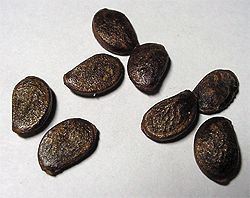 In late September, one of our favorite nature activities at Hilton Pond Center is running mist nets--not only because we're likely to catch fall migrant birds, but it's also when persimmon fruits along our trails are ripening and plopping to the ground. "Plop" is definitely the correct word, since some of these one-inch berries tumble from a majestic persimmon tree that towers nearly 60 feet into the canopy. Many of the fruits split open to reveal four to eight dark, flat seeds (above right), and that's when we pick 'em up, knock off an ant or two, and savor their succulent sweetness--one 'simmon at a time.
In late September, one of our favorite nature activities at Hilton Pond Center is running mist nets--not only because we're likely to catch fall migrant birds, but it's also when persimmon fruits along our trails are ripening and plopping to the ground. "Plop" is definitely the correct word, since some of these one-inch berries tumble from a majestic persimmon tree that towers nearly 60 feet into the canopy. Many of the fruits split open to reveal four to eight dark, flat seeds (above right), and that's when we pick 'em up, knock off an ant or two, and savor their succulent sweetness--one 'simmon at a time. the tree's dogwood-like leaves (below left) also will have fallen, so at least any remaining 'simmons will be visible. Our rule is that you never pick persimmons off the tree, but if one falls from a lofty limb, it must be ripe, so it's okay to go ahead and eat it . . . and slide the smooth, slippery seeds around in your mouth . . . and squeeze the sweet, sticky pulp 'twixt tongue and palate, carefully extracting all that indescribable fruity flavor. Then you must spit those seeds as far as possible, doing what you can to spread them around after tasting the "food of the gods" that enveloped them. (Pardon us if we wax a bit poetic, but if you've never tasted a ripe persimmon--or, worse yet, only tasted an unripe one--then you really don't know what you're missing!)
the tree's dogwood-like leaves (below left) also will have fallen, so at least any remaining 'simmons will be visible. Our rule is that you never pick persimmons off the tree, but if one falls from a lofty limb, it must be ripe, so it's okay to go ahead and eat it . . . and slide the smooth, slippery seeds around in your mouth . . . and squeeze the sweet, sticky pulp 'twixt tongue and palate, carefully extracting all that indescribable fruity flavor. Then you must spit those seeds as far as possible, doing what you can to spread them around after tasting the "food of the gods" that enveloped them. (Pardon us if we wax a bit poetic, but if you've never tasted a ripe persimmon--or, worse yet, only tasted an unripe one--then you really don't know what you're missing!)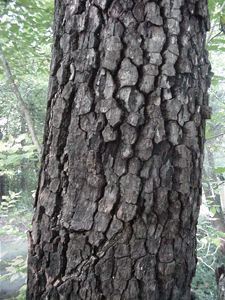 Common Persimmon, Diospyros virginiana, occurs in nearly every major habitat in the southeastern U.S. In the Carolinas, it's one of few tree species found in the Coastal Plain, Sandhills, Piedmont, and Mountain provinces. At Hilton Pond Center, it grows slowly as an early successional shrub in old fields and reaches maximum size only when unshaded by leaf canopy; if other hardwoods or pines overtake it, the persimmon remains a forest understory tree, but at almost any size is still identifiable by its black "alligator-skin" bark (right). The wood of large persimmon trees is extremely hard, hence its use in golf club heads; mountain craftsmen sometimes select the wood for turned pieces with interesting grain, but it can be quite difficult to work.
Common Persimmon, Diospyros virginiana, occurs in nearly every major habitat in the southeastern U.S. In the Carolinas, it's one of few tree species found in the Coastal Plain, Sandhills, Piedmont, and Mountain provinces. At Hilton Pond Center, it grows slowly as an early successional shrub in old fields and reaches maximum size only when unshaded by leaf canopy; if other hardwoods or pines overtake it, the persimmon remains a forest understory tree, but at almost any size is still identifiable by its black "alligator-skin" bark (right). The wood of large persimmon trees is extremely hard, hence its use in golf club heads; mountain craftsmen sometimes select the wood for turned pieces with interesting grain, but it can be quite difficult to work.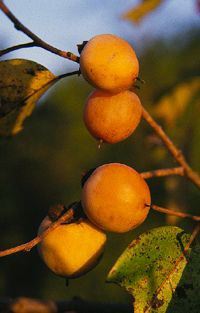 In the unripe fruit, astringent chemicals--tannins, mostly-- turn one's mouth inside-out, which undoubtedly deters animals from eating a 'simmon before its seeds are mature and ready for dispersal. Being rather dense, persimmon seeds are not the sort you might expect to be blown by wind. Instead, they are often carried long distances by animals that share our penchant for the persimmon taste. Deer and wild turkey gulp the fruit in its entirety, as do foxes, raccoons, skunks, and opossums, and all these animals later deposit seeds in their droppings--each seed thus gaining an individual dose of fertilizer.
In the unripe fruit, astringent chemicals--tannins, mostly-- turn one's mouth inside-out, which undoubtedly deters animals from eating a 'simmon before its seeds are mature and ready for dispersal. Being rather dense, persimmon seeds are not the sort you might expect to be blown by wind. Instead, they are often carried long distances by animals that share our penchant for the persimmon taste. Deer and wild turkey gulp the fruit in its entirety, as do foxes, raccoons, skunks, and opossums, and all these animals later deposit seeds in their droppings--each seed thus gaining an individual dose of fertilizer.